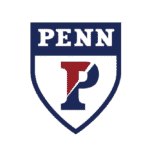Build up leaders, not just resumes.
The Admissions Angle
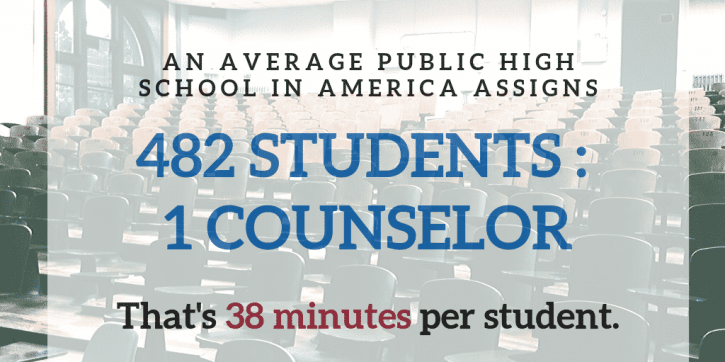
It’s no secret that high school students get little guidance in the college admissions process. Public school students receive an average of just 38 minutes of guidance in their four years attending. Most students don’t even know who their guidance counselor is until the end of their junior year.
Why does this happen? The simple answer is a matter of math. Public schools lack funds for both teachers and guidance counselors. With the lack of funds for salaries, oftentimes counselors are responsible for hundreds of students at once. In fact, the national average for public schools is 482 students for 1 counselor.
Whether we like it or not, a student’s college admissions results and matriculation are one of the biggest decisions of their lives, determining the trajectory of their careers, their experiences with diverse people and ideas, the social circles they’ll run in, and where they decide to live after graduation. It’s an event as impactful as the birth of a child or a wedding. As many married couples meet at university, you could even say that admission to college can be even more significant than a wedding. Regardless, the status quo is simply not enough. Can you imagine working with a wedding planner who cuts you off after 38 minutes?


Even beyond the admissions decision itself, high school is a rapid developmental period in a student’s life. During this time, students develop habits that will stick with them for years to come. More important than the college admissions decision are the skills of setting goals, planning the steps to reach them, and efficiently putting in the work to succeed. At its core, the college admissions process should be about developing the confidence to lead others and communicate effectively. To become aware of their privilege or their disadvantage and to leverage it for the betterment of their communities. These skills for long term success should be the purpose of any mentor.
How We Help
Mentorship Services
From as early as 8th grade, craft an Admissions Angle that suits your student’s strengths and gives them an edge for admissions. Our services start with a consistent, personal relationship with each and every one of our students.

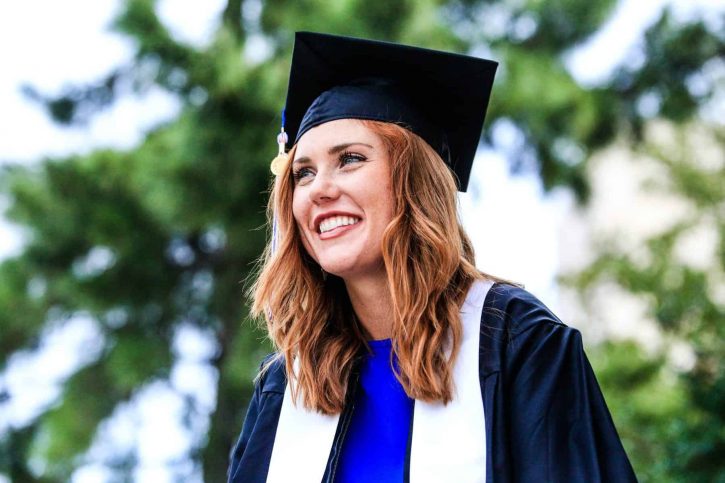
College Application Services
Get help on college applications starting from the end of 11th grade. Recommendations, resumes, personal statements, admissions strategy, essays, essays, and more essays.
About Us
Learn about who we are, our admissions philosophy, and our years of experience in the field. Also check our our track record of success and some things that our previous students have said about us.

College Admissions Services
Schedule a Free Consultation
Meet with Alex one-on-one via video chat to talk about your son/daughter’s admissions plan. Afterwards, receive a no-obligation Customized College Roadmap (CCR) with advice on courses, extracurricular activities, standardized tests, and Admissions Angle strategy.
Step 1
We meet with the parents to learn about their son/daughter’s interests, strengths, weaknesses, and concerns
Step 2
We meet with the student to get to know them personally and independent from the parents
Step 3
We present the Customized College Roadmap (CCR) to both the parents and the student
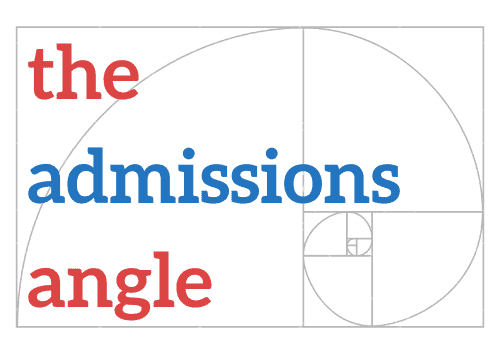
The Admissions Angle is at the core of our college admissions philosophy and its primary purpose is to help a student to stand out from the rest of the applicant pool. Essentially, it advocates for depth of expertise and interest in a few areas rather than a shallow understanding of many areas. Depth over breadth.
At the Admissions Angle, we provide our students with the time and attention they need to craft a compelling college admissions narrative. What does that look like you ask? Well, we use something called an Admissions Angle.
We know that the best way to be forgotten by an admissions officer is to come off as “well-balanced”, which is just a nicer way of saying unfocused. Well-balanced students have a number of problems in their academic profile:
- Lack of cohesion in their courses/extracurricular choices.
- Lack of time spent in a single activity/project to make a meaningful impact/achievement.
- Lack of self-awareness of who they are or what mark they want to leave on the world.

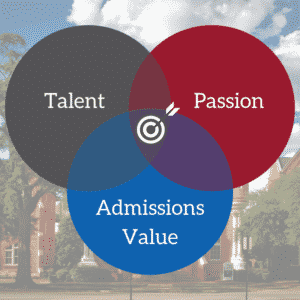
The best way to avoid this “well-balanced” trap is to create an Admissions Angle, and any effective Angle meets three criteria:
- Something with admissions value
- Something the student is good at
- Something the student loves
Without all three criteria, Admissions Angles can be unappealing (love + good at), unsupported (love + admissions value), or uninspired (good at + admissions value).
Demonstrated Success
Class of '24
Caltech University
University of Pennsylvania
Johns Hopkins University
Vanderbilt University
Emory University
University of California – Berkeley
Harvey Mudd College
University of California – Los Angeles
University of Michigan
New York University
Boston University
University of California – San Diego
University of California – Irvine
University of California – Davis
University of Illinois – Urbana Champaign
Purdue University
Northeastern University
University of Washington
George Washington University
University of California – Santa Cruz
Case Western Reserve University
Colorado School of Mines
University of Minnesota
University of Massachusetts Amherst
Penn State University
Santa Clara University
Rutgers University
Drexel University
University of Arizona
